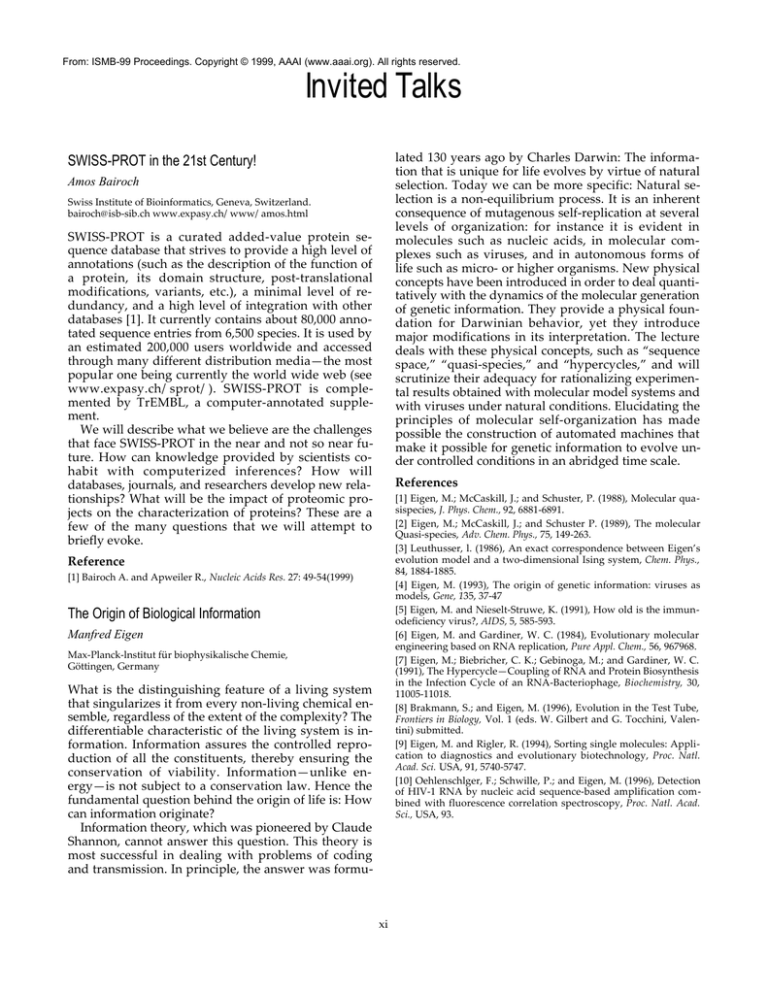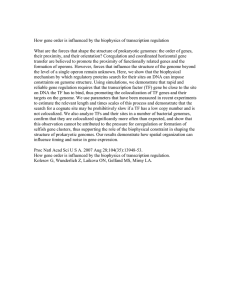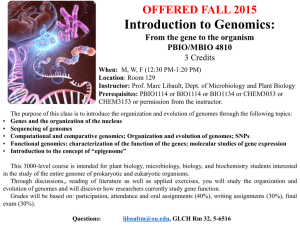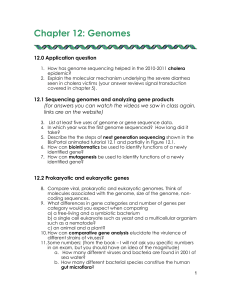
From: ISMB-99 Proceedings. Copyright © 1999, AAAI (www.aaai.org). All rights reserved.
Invited Talks
lated 130 years ago by Charles Darwin: The information that is unique for life evolves by virtue of natural
selection. Today we can be more specific: Natural selection is a non-equilibrium process. It is an inherent
consequence of mutagenous self-replication at several
levels of organization: for instance it is evident in
molecules such as nucleic acids, in molecular complexes such as viruses, and in autonomous forms of
life such as micro- or higher organisms. New physical
concepts have been introduced in order to deal quantitatively with the dynamics of the molecular generation
of genetic information. They provide a physical foundation for Darwinian behavior, yet they introduce
major modifications in its interpretation. The lecture
deals with these physical concepts, such as “sequence
space,” “quasi-species,” and “hypercycles,” and will
scrutinize their adequacy for rationalizing experimental results obtained with molecular model systems and
with viruses under natural conditions. Elucidating the
principles of molecular self-organization has made
possible the construction of automated machines that
make it possible for genetic information to evolve under controlled conditions in an abridged time scale.
SWISS-PROT in the 21st Century!
Amos Bairoch
Swiss Institute of Bioinformatics, Geneva, Switzerland.
bairoch@isb-sib.ch www.expasy.ch/www/amos.html
SWISS-PROT is a curated added-value protein sequence database that strives to provide a high level of
annotations (such as the description of the function of
a protein, its domain structure, post-translational
modifications, variants, etc.), a minimal level of redundancy, and a high level of integration with other
databases [1]. It currently contains about 80,000 annotated sequence entries from 6,500 species. It is used by
an estimated 200,000 users worldwide and accessed
through many different distribution media—the most
popular one being currently the world wide web (see
www.expasy.ch/sprot/). SWISS-PROT is complemented by TrEMBL, a computer-annotated supplement.
We will describe what we believe are the challenges
that face SWISS-PROT in the near and not so near future. How can knowledge provided by scientists cohabit with computerized inferences? How will
databases, journals, and researchers develop new relationships? What will be the impact of proteomic projects on the characterization of proteins? These are a
few of the many questions that we will attempt to
briefly evoke.
References
[1] Eigen, M.; McCaskill, J.; and Schuster, P. (1988), Molecular quasispecies, J. Phys. Chem., 92, 6881-6891.
[2] Eigen, M.; McCaskill, J.; and Schuster P. (1989), The molecular
Quasi-species, Adv. Chem. Phys., 75, 149-263.
[3] Leuthusser, l. (1986), An exact correspondence between Eigen’s
evolution model and a two-dimensional Ising system, Chem. Phys.,
84, 1884-1885.
[4] Eigen, M. (1993), The origin of genetic information: viruses as
models, Gene, 135, 37-47
[5] Eigen, M. and Nieselt-Struwe, K. (1991), How old is the immunodeficiency virus?, AIDS, 5, 585-593.
[6] Eigen, M. and Gardiner, W. C. (1984), Evolutionary molecular
engineering based on RNA replication, Pure Appl. Chem., 56, 967968.
[7] Eigen, M.; Biebricher, C. K.; Gebinoga, M.; and Gardiner, W. C.
(1991), The Hypercycle—Coupling of RNA and Protein Biosynthesis
in the Infection Cycle of an RNA-Bacteriophage, Biochemistry, 30,
11005-11018.
[8] Brakmann, S.; and Eigen, M. (1996), Evolution in the Test Tube,
Frontiers in Biology, Vol. 1 (eds. W. Gilbert and G. Tocchini, Valentini) submitted.
[9] Eigen, M. and Rigler, R. (1994), Sorting single molecules: Application to diagnostics and evolutionary biotechnology, Proc. Natl.
Acad. Sci. USA, 91, 5740-5747.
[10] Oehlenschlger, F.; Schwille, P.; and Eigen, M. (1996), Detection
of HIV-1 RNA by nucleic acid sequence-based amplification combined with fluorescence correlation spectroscopy, Proc. Natl. Acad.
Sci., USA, 93.
Reference
[1] Bairoch A. and Apweiler R., Nucleic Acids Res. 27: 49-54(1999)
The Origin of Biological Information
Manfred Eigen
Max-Planck-lnstitut für biophysikalische Chemie,
Göttingen, Germany
What is the distinguishing feature of a living system
that singularizes it from every non-living chemical ensemble, regardless of the extent of the complexity? The
differentiable characteristic of the living system is information. Information assures the controlled reproduction of all the constituents, thereby ensuring the
conservation of viability. Information—unlike energy—is not subject to a conservation law. Hence the
fundamental question behind the origin of life is: How
can information originate?
Information theory, which was pioneered by Claude
Shannon, cannot answer this question. This theory is
most successful in dealing with problems of coding
and transmission. In principle, the answer was formu-
xi
Combinatorial Problems in Gene Expression
Analysis Using DNA Microarrays
Computational Genomics:
Biological Discovery in Complete Genomes
Richard M. Karp
Anthony R. Kerlavage
University of Washington, Seattle, WA, USA
Celera Genomics, Rockville, MD, USA
With the advent of DNA microarrays, data about the
transcription rates of genes can be acquired far more
efficiently than ever before. A single array experiment
can measure the levels of thousands of mRNAs. By
measuring these levels under different experimental
conditions one can observe the effects of different external conditions or gene knockouts and inductions on
the functioning of cells. By measuring transcription in
different tissue samples one can discover diagnostic
tests for distinguishing normal tissue from neoplastic
tissue.
The results of m array experiments on a set of n
genes can be represented by a m x n matrix of numbers. The i-j entry of the matrix gives the transcription
level of the jth gene in the ith experiment. The experiments may be performed on different tissue samples,
or on the same tissue sample or cell colony under different conditions, affected by temperature, time,
growth conditions, drug treatments, gene knockouts
and inductions etc.. A fundamental tool for mining
this data is to perform clustering to partition the genes
into sets of coregulated genes or to partition the experiments into sets of conditions with similar patterns of
gene transcription. We will describe several different
approaches to these clustering problems. One can also
go beyond clustering to look for more refined patterns
in the data; for example, certain sets of genes may behave similarly under certain experimental conditions,
even though they are not coregulated under all conditions. We will describe some approaches to discovering such patterns of conditional coregulation.
One would like to use DNA microarrays to discover
the structure of the pathways that regulate gene expression in cells. A pathway can be regarded as a dynamical system whose state includes the abundancies
of certain mRNAs and proteins, and whose inputs include the experimental conditions described above. A
variety of mathematical models have been proposed
for such pathways: the state variables can be treated as
either discrete or continuous, the dynamics can be deterministic, nondeterministic or stochastic, and one can
be interested either in transient behavior or in steadystate behavior. We shall describe some initial work on
the design of efficient experiments for inferring or verifying the structure of such pathways.
This talk represents joint work with many colleagues at the University of Washington and other institutions in the Seattle area.
The field of genomics was radically changed with the
sequencing of the first complete microbial genome,
Haemophilus influenzae by The Institute for Genomic
Research (TIGR) [1]. This project made it apparent that
the DNA of entire complex organisms many
megabases in size could be accurately and rapidly sequenced by using a “shotgun” sequencing strategy.
Since that time, TIGR and other labs have combined to
completely sequence the genomes of over 20 microbes.
Knowing the complete genome sequence of the
pathogens in this group will open up exciting opportunities to develop novel pharmaceuticals, biologics,
and vaccines. The genomes of two important eukaryotic model organisms, S. cerevisiae [2] and C. elegans [3]
have also been completed. In addition, several chromosomes from P. falciparum and A. thaliana are finished and these entire genomes will soon be complete.
Across all of these species, nearly half of the candidate genes that have been identified cannot be assigned a definitive biological role, leaving open a
tremendous opportunity for functional as well as
computational genomics. On the other hand, by a
combination of molecular sequence analysis techniques, new insights have been made concerning the
metabolic pathways, cell-surface receptor and transporter complement, and phylogeny of these organisms. The availability of these complete genomes
makes comparative genomic analysis possible, leading
to the discovery of synteny among organisms as well
as regulatory and developmental networks controlling
the expression of genes. The integration and semantic
representation of this wealth of data will be critical to
our ability to understand it.
At Celera Genomics we have set our goal to become
the definitive source of genomic and associated medical information that will be used by scientists to develop a better understanding of the biological processes in humans and agriculturally important organisms and deliver improved health care in the future.
Using breakthrough DNA sequencing technology, we
are operating a genomics sequencing facility with an
expected capacity greater than that of the current
combined world output[4]. The early focus at Celera
will be on completing the genomes of human, mouse,
Drosophila, and rice. While the size of these genomes
and the speed with which they will be sequenced will
present enormous computational challenges for the
discovery and characterization of genes, they represent
an enormous opportunity to advance the complete
understanding of living systems.
xii
recombination events that manifest in domain rearrangement at the protein level. Previously, such rearrangements were associated primarily with exon
shuffling but the analysis of complete genomes shows
that they are critically important also in the prokaryotic world where this mechanism is not operative.
Examination of phylogenetic patterns for families of
orthologous proteins also results in more specific conclusions some of which may have far-reaching consequences. In particular, it is now clear that the basic
DNA replication machineries (that is, the replicative
DNA polymerases, primases, helicases, and several
other proteins) in bacteria and in archaea/eukaryotes
are not orthologous and may have evolved independently. This is in sharp contrast with the remarkable
conservation of the components of the translation apparatus and the core transcription machinery. Other
components of the DNA replication system, such as
the sliding clamp (PCNA) and the clamp-loader ATPase, however, are universal. Apparently the most
parsimonious, even if somewhat unconventional, interpretation of these observations is that the common
ancestor of all extant cellular life forms (the so-called
cenancestor) did not possess a modern-type, DNAbased replication and expression system although it
did encode advanced translation and transcription machineries and a considerable repertoire of metabolic
enzymes. Instead of a dsDNA genome, the cenancestor
might have had a mixed system of small RNA and
DNA genetic elements that were inter-converted via
cycles of transcription and reverse transcription. This
model seems to be able to account for both universal
and distinct components of the DNA replication machinery in bacteria and archaea-eukaryotes.
Further genome sequencing, particularly of
genomes of deep-branching organisms, will put these
concepts to test and in any case, will add more substance for critical analysis. This must be complemented
by further developments of methods for theoretical
and ultimately experimental analysis of evolution on
the basis of multiple genome comparison.
Acknowledgments
I am grateful to L. Aravind and Detlef Leipe for numerous stimulating discussions, without which these
ideas could not have been developed in a clear form. I
am aware and appreciative of the major contribution
of Carl Woese to our understanding of the possible nature of the Universal Ancestor (Woese, 1998).
References
[1] Whole-Genome Random Sequencing and Assembly of
Haemophilus influenzae Rd. Fleischmann, R. D. et al. Science 269: 496512, 1995.
[2] The Yeast Genome Directory. Nature 387(Suppl): 5-105, 1997.
[3] Genome Sequence of the Nematode C. elegans: A Platform for Investigating Biology. The C. elegans Sequencing Consortium. Science
282: 2012-2018, 1998.
[4] Shotgun Sequencing of the Human Genome. Venter, J. C.;
Adams, M. D.; Sutton, G. G.; Kerlavage, A. R.; Smith, H. O.; and
Hunkapiller, M. Science 280: 1540-1542, 1998.
Comparative Genomics: Is It Changing the
Paradigm of Evolutionary Biology?
Eugene V. Koonin
National Center for Biotechnology Information, National Library of
Medicine, National Institutes of Health, Bethesda, MD, USA
About 20 complete genome sequences of cellular life
forms—bacteria, archaea, and eukaryotes—are currently available, and many more are in the pipeline.
Considerable comparative analysis of these genomes
has already been performed, and while even more
challenging work lies ahead, it is fair to ask at this
juncture, what is the impact of this research on biology
in general. In my opinion, comparative analysis of
complete genome has already affected our ideas of
what biological evolution is to such an extent that it is
appropriate to claim a paradigm shift in evolutionary
biology.
Computer analysis of complete genomes of unicellular organisms shows that protein sequences are in general highly conserved in evolution, with at least 70% of
them containing ancient conserved regions. This allows us to delineate families of orthologs across a wide
phylogenetic range and in many cases, predict protein
functions with reasonable confidence. Once a robust
set of such orthologous families is established, it is
possible to examine the pattern of phylogenetic representation (or for brevity, simply aphylogenetic pattern)
for each of them. Such an examination readily shows
that for the great majority of orthologous families, the
phylogenetic distribution is quite patchy, and in many
cases, unexpected. Only ~100 families, most of which
include components of the translation machinery, are
universally conserved in all sequenced genomes.
These observations indicate that horizontal gene transfer and lineage-specific gene loss are not inconsequential evolutionary quirks but rather prevailing forces of
evolution, at least in the prokaryotic world. On many
occasions, in detailed studies of protein super families
and even entire functional systems, such as those for
DNA repair and programmed cell death, it is now
possible to construct parsimonious evolutionary scenarios that include a number of distinct events of horizontal gene transfer and gene loss. These studies show
that horizontal transfer and lineage-specific loss of entire genes are complemented by numerous intragenic
References
[1] Aravind, L.; Tatusov, R. L.; Wolf, Y. I.; Walker, D. R.; Koonin, E.
V. Evidence for massive gene exchange between archaeal and bacterial hyperthermophiles. Trends Genet, 14: 442-444, 1998.
[2] Jeffares, D. C.; Poole, A. M.; Penny D. Relics from the RNA
world. J. Mol. Evol. 46: 18-36 (1998).
[3] Koonin, E. V.; Mushegian, A. R.; Galperin, M. Y.; Walker, D. R.
Comparison of archaeal and bacterial genomes: computer analysis
of protein sequences predicts novel functions and suggests a
chimeric origin for the archaea. Mol. Microbiol. 25: 619-637, 1997.
[4] Makarova, K. S.; Aravind, L.; Galperin, M. Y.; Tatusov, R. L.;
xiii
chip arrays. Here we discuss an additional approach
which is also capable of providing function or at least
the cellular role of the genes uncovered in genomic sequencing projects. Advances in mass spectrometry
over the last few years now make it possible to identify
large numbers of gel separated proteins at minute levels (low femtomole/low nanogram) [4], [5]. Proteins of
interest can be precipitated using gene tagging or antibody methods, revealing interacting proteins on one or
two dimensional gels which can then be identified by
mass spectrometry [1], [2]. We show that this technology can be scaled up to large numbers and that significant biological results have already been obtained both
in structural protein complexes and in transient complexes such as the ones involved in signaling [3], [6]. In
principle this technology can lead to a protein interaction map of the cell. The approach should be accompanied by bioinformatics tools which interpret the
empirically found interactions. We conclude that mass
spectrometry of multi-protein complexes is a valid approach which rapidly yields functional information on
open reading frames identified in sequencing projects.
Wolf, Y. I.; Koonin, E. V. Comparative genomics of the archaea: universal and unique protein families. Genome Res., in press, 1999.
[5] Mushegian, A. R. and Koonin, E. V. A minimal gene set for cellular life derived by comparison of complete bacterial genomes. Proc.
Natl. Acad. Sci. USA., 93: 10268-10273, 1996.
[6] Poole, A. M.; Jeffares, D. C., Penny D. The path from the RNA
world. J. Mol. Evol. 46, 1-17 (1998).
[7] Tatusov, R. L.; Koonin, E. V.; Lipman, D. J. A genomic perspective on protein families. Science, 278: 631-637, 1997.
[8] Woese, C. The universal ancestor. Proc. Natl. Acad. Sci. USA 95:
6854-6859 (1998).
Genes, Chips, and Genomes
Robert J. Lipshutz
Affymetrix, Inc., Santa Clara, CA, USA
The Human Genome Project is providing life science
researchers with access to unprecedented amounts of
raw sequence data. To effectively harness this data and
apply it to biomedical research, therapeutic development, clinical practice, and patient management, powerful new tools for measuring gene expression, polymorphism discovery, and genotyping are needed.
GeneChip® probe arrays are powerful tools to meet
these requirements. Light-directed chemical synthesis
is used to generate miniaturized, high-density arrays
of oligonucleotide probes called GeneChip probe arrays. Application specific oligonucleotide arrays have
been used to rapidly scan known genes and discover
genetic variants, to detect the presence of known alternative alleles, and to simultaneously measure the
expression of thousands of individual genes. An integrated GeneChip® system including instrumentation
and software has been developed for array hybridization, fluorescent detection, and data acquisition and
analysis. Experiments demonstrating the effectiveness
of these methods of genetic analysis will be described
as well as new bioinformatics challenges generated by
the new information.
References may be found at www.affymetrix.com/
technology/papers.html
References
[1] Lamon, A. I. and Mann, M. (1997). Cell Biology and the Genome
Projects—a concerted strategy for characterizing multi-protein
complexes using mass spectrometry. Trends in Cell Biology 7: 139-142.
[2] Neubauer, G.; Gottschalk, A.; Fabrizio, P.; Séraphin, B.; Lhrmann,
R.; and Mann, M. (1997). "Identification of the proteins of the yeast
U1 small nuclear ribonucleoprotein complex by Mass Spectrometry." Proceedings of the National Academy of Sciences USA 94: 385-390.
[3] Neubauer, G.; King, A.; Rappsilber, J.; Calvio, C.; Watson, M.;
Ajuh, P.; Sleeman, J.; Lamond, A. I.; and Mann, M. (1998). Mass
spectrometry and EST-database searching allows characterization of
the multi-protein spliceosome complex. Nat Genet 20: 46-50.
[4] Shevchenko, A.; Jensen, O. N.; Podtelejnikov, A. V.; Sagliocco, F.;
Wilm, M.; Vorm, O.; Mortensen, P.; Shevchenko, A.; Boucherie H.;
and Mann, M. (1996). Linking Genome and Proteome by Mass
Spectrometry: Large Scale Identification of Yeast Proteins From Two
Dimensional Gels. Proceedings of the National Academy of Sciences USA
93: 14440-14445.
[5] Wilm, M.; Shevchenko, A.; Houthaeve, T.; Breit, S.; Schweigerer,
L.; Fotsis T.; and Mann; M. (1996). Femtomole Sequencing of Proteins from Polyacrylamide Gels by Nano Electrospray Mass Spectrometry. Nature 379: 466-469.
[6] Yaron, A.; Hatzubai, A.; Davis, M.; Lavon, I.; Amit, S.; Manning,
A.; Andersen, J.; Mann, M.; Mercurio, F.; and Ben-Neriah, Y. (1998).
Identification of the receptor component of the IkappaBalpha-ubiquitin ligase. Nature 396: 590-4.
Gene Function via the Mass Spectrometric
Analy sis of Multi-Protein Complexes
Matthias Mann
Protein Interaction Laboratory, University of Southern Denmark—
Odense University, Odense, Denmark. (www.pil.sdu.dk)
The anticipated availability of virtually all human gene
sequences already within a year will usher in the
“post-genome era” of biology sooner than expected.
We now require large-scale experimental approaches
which will use the genomic information but add another dimension of information to it. Methods which
are already being applied include large scale two hybrid screening (currently for small to medium genome
sizes) and large scale expression analysis via DNA
xiv
algorithms are required to predict protein structure
and function from sequence. To illustrate the computational challenges, the following topics currently being
considered in our laboratory will be described:
• The need to encapsulate expert knowledge in protein structure prediction
• The strategy to assign protein folds to genome sequences
• The detection of remote protein homologues using
information from protein structures
• The use of inductive logic programming, a branch
of machine leaning, to identify principles of protein
folding.
Exploiting Protein Structure in the
Post-Genome Era
Michael J. E. Sternberg1
Paul A. Bates 1, Lawrence A. Kelley1, Robert M. MacCallum1, Arne Müller2, Stephen Muggleton 2, Marcel Turcotte1
(1) Biomolecular Modelling Laboratory, Imperial Cancer Research
Fund, London, England http://www.icnet.uk/bmm. (2) Department of Computer Science, University of York, York, England
Diverse and innovative computational approaches are
required to exploit the information encoded in protein
structures so the knowledge can be used to interpret
the explosion of genome sequence data. In particular
xv










